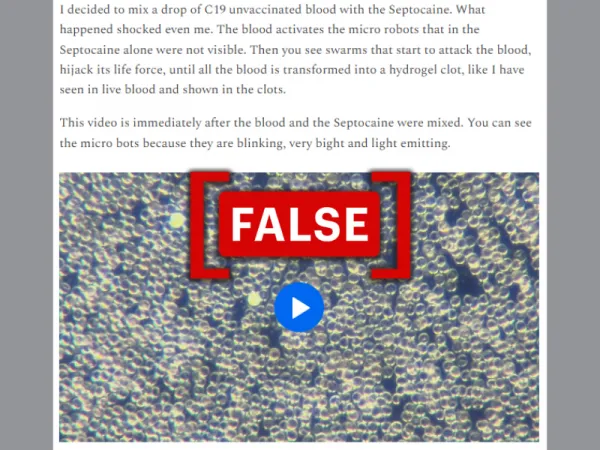By: Christian Haag
January 30 2024
No, blood does not activate microrobots in septocaine

Screenshot of the claim being shared online. (Source: Substack/Screenshot/Edited by Logically Facts)
The Verdict False
Micro/nanorobots are not present in commercially available anesthetics as they have not passed animal testing or gone to clinical studies.
Context
A video circulating on social media falsely claims that the anesthetic Septocaine and COVID-19 vaccines contain microrobots that "hijack" and kill red blood cells.
The video claims that the microrobots activate when mixed with the blood of someone not vaccinated against COVID-19 and refers to a blog post published on Substack on October 18, 2023. A version of the claim has also been uploaded to Bitchute.
Screenshot of the claim.
(Source: Substack/Screenshot/Edited by Logically Facts)
However, the claim is false. Research on micro/nanorobots for drug delivery systems is only at the animal testing stage and has not yet reached human clinical trials.
Septocaine, microrobots, and blood
Septocaine is a local anesthetic primarily used in dental procedures. Logically Facts inspected three ingredient lists for Septocaine, one from Daily Med, one from the Swedish Medical Products Agency, and one from one of the producers of the anesthetics, Septodont. None of the lists show that the drug contains any nanotechnology.
Septocaine contains five ingredients. The two active ingredients are articaine hydrochloride and epinephrine bitartrate, also known as adrenaline. The articaine numbs the pain, and the adrenaline slows the absorption of the anesthetic into the patient's circulation, prolonging the effect. The inactive ingredients are sodium chloride, sodium metabisulfite, and sodium hydroxide.
The use of micro/nanorobots in anesthetics or drug delivery systems is still developing. So far, tests have only been conducted on animals, and there have been no human clinical trials. However, the results have been promising, and there are high hopes for using micro/nanorobots to enhance individualized drug delivery and treatment.
The substack blog post claims microrobots are used in dental anesthetics, referencing a 2018 article titled "Nanotechnology in dentistry: Unleashing the hidden gems." However, the article does not discuss the use of microrobots in dental anesthetics and only outlines potential areas of dentistry where nanotechnology can be used.
There is also no reason to believe that the blood of someone vaccinated differs from someone not vaccinated against COVID-19. The pandemic sparked a "pure blood" movement, which believed that blood from a vaccinated individual caused contamination. This has spurred advocacy for special blood banks, and patients have refused transfusions for life-saving surgeries. However, there is no evidence that blood differs depending on vaccination status.
A statement by AABB, America's Blood Centers, and the American Red Cross reports that "There is no scientific evidence that demonstrates adverse outcomes from the transfusions of blood products collected from vaccinated donors and, therefore, no medical reason to distinguish or separate blood donations from individuals who have received a COVID-19 vaccination."
Nanotechnology in COVID-19 vaccines
There have been many false claims regarding the presence of nanotechnology in COVID-19 vaccines, particularly that they can connect the vaccinated to the 5G network. The Instagram video claims microbots have also been found in COVID-19 vaccines. However, there is no evidence for this claim.
The verdict
Nanorobots have not passed animal testing and thus are not available for on-market drugs and medication. Therefore we have marked this claim as false.
Reference Links
Read this fact-check in:


